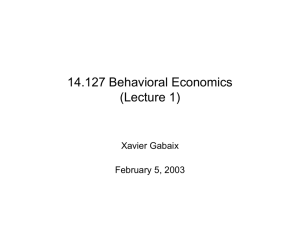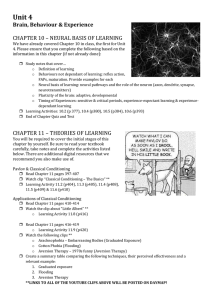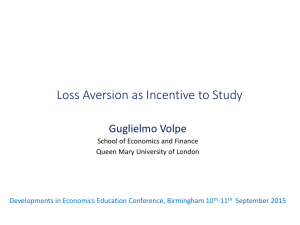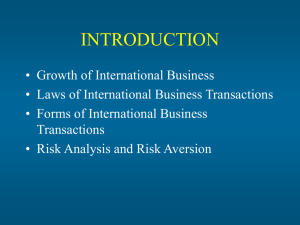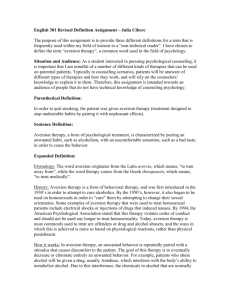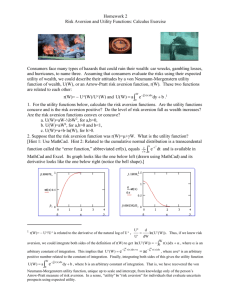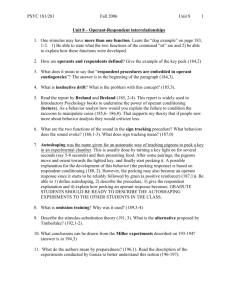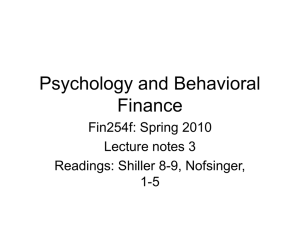Choices involving risk
advertisement
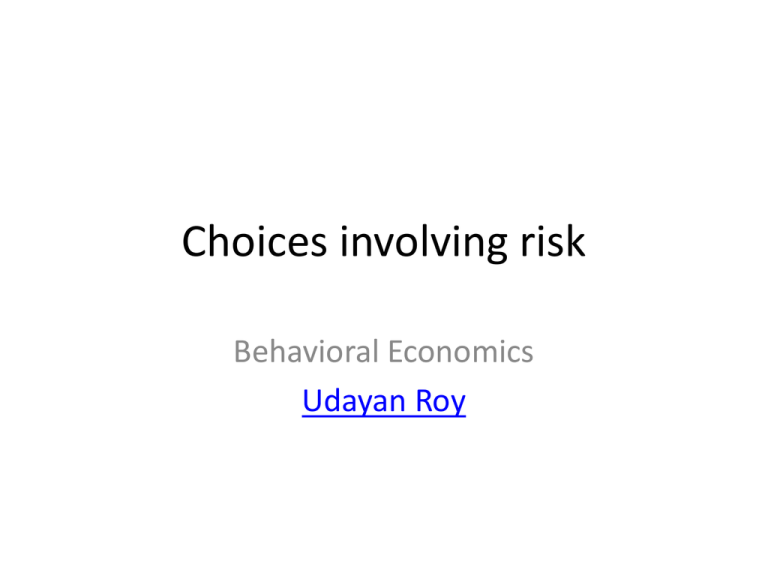
Choices involving risk Behavioral Economics Udayan Roy MISCONCEPTIONS OVER RISK Trouble Assessing Probabilities • People tend to make specific errors in assessing probabilities • Hot-hand fallacy is the belief that once an event has occurred several times in a row it is more likely to repeat – Arises when people can easily invent explanations for streaks, e.g., basketball • Gambler’s fallacy is the belief that once an event has occurred it is less likely to repeat – Arises when people can’t easily invent explanations for streaks, e.g., state lotteries • Both fallacies have important implications for economic behavior, e.g., clearly relevant in context of investing • Overconfidence causes people to: – Overstate the likelihood of favorable events – Understate the uncertainty involved 13-3 Hot-hand fallacy • Philadelphia 76ers, 48 home games, 1980-81 season The Representativeness Heuristic • The hot-hand fallacy is an example of the representativeness heuristic (rule of thumb) – The more that A fits our mental image or stereotype of category B, the more we tend to think that A belongs to category B. – When a basketball player’s streak of successes fails to meet our stereotype of a random sequence of successes, we conclude that he/she has a “hot hand” The Representativeness Heuristic: Who is Linda? • Experimental subjects were told the following: – Linda is thirty-one years old, single, outspoken, and very bright. She majored in philosophy. As a students, she was deeply concerned with issues of discrimination and social justice and also participated in anti-nuclear demonstrations.” – Then people were asked to rank, in order of likelihood, eight possible futures for Linda – Of those eight futures were • “bank teller” and • “bank teller and active in the feminist movement.” The Representativeness Heuristic: Who is Linda? • Most people said that Linda was less likely to be a bank teller than to be a bank teller and active in the feminist movement • This is not surprising • But it is a logical mistake Gambler’s fallacy • A study of nearly 1800 daily drawings between 1988 and 1992 in a New Jersey lottery showed that after a number came up a winner, bettors tended to avoid it Overconfidence • In one study of US students with an average age of 22, 82% ranked their driving ability among the top 30% of their age group • Video: Your Mind and Your Money - Investor Overconfidence, Monday, February 08, 2010, Nightly Business Report, PBS Overconfidence in the stock market • Brad Barber and Terrance Odean studied the investment performance of 66,465 households with discount brokerage accounts • During the period studied, households that trade infrequently received an 18% return on their money, and • households that trade most actively got an 11.3% return Overconfidence and gender • The extent of trading was found to be influenced by gender: the men traded a lot more than the women • Psychologists commonly find that men tend to have excessive confidence in their own abilities, while women tend to be more realistic. • Psychologists tend to refer to this aspect of men’s behavior as self-serving attribution bias Overconfidence and gender • Men tend to think their successes are a result of their own skill, rather than dumb luck, and so become overconfident • This overconfidence can have financial repercussions. – In the study by Barber and Odean, men traded 45% more than women – The average return on investment to men was a full percentage point lower than the return to women Overconfidence • In the manufacturing sector, – more than 60% of new entrants exit within five years; – nearly 80% exit within ten years • The high failure rate may be partly due to overconfidence – In a survey of nearly 3000 new business owners, • 81% said they had more than 70% chance of success • though only 39% said that a business like theirs would be that likely to succeed • One-third said they were 100% certain to succeed Law of small numbers • People tend to read too much significance into small samples, especially when the samples represent personal experience Larger hospital, smaller hospital • A certain town has two hospitals. In the larger hospital about 45 babies are born each day, and in the smaller hospital about 15 babies are born each day. • As you know, about 50 percent of all babies are boys. However, the exact percentage varies from day to day. Sometimes it may be higher than 50 percent, sometimes lower. • For a period of one year, each hospital recorded the days on which more than 60% of the babies born were boys. • Which hospital do you think recorded more such days? Larger hospital, smaller hospital • In a survey of college students, – 22 percent said “larger hospital” – 56 percent said “equal for both” – 22 percent said “smaller hospital” (correct) • People underestimate how different samples can be from the population PREFERENCES TOWARD RISK Preferences Toward Risk • Here are two puzzles involving observed behavior and risk preferences • Overemphasis on low-probability events: – People show aversion to risk in gambles with moderate odds – However, some of these same people take gambles with very high payoffs with very low probabilities (lotto), which indicates a love of risk! • Aversion to very small risks: – Many people also appear reluctant to take even very tiny shares of certain gambles that have positive expected payoffs – This implies a level of risk aversion so high that it is impossible to explain the typical person’s willingness to take larger financial risks 13-18 Low-probability events grab all the attention • A: Win $2,500 • B: Win $5,000 with 1/2 probability • C: Win $5 • D: Win $5,000 with 1/1000 probability In both cases, the second option takes the first option and reduces the probability and increases the prize by the same factor Most people choose A over B, suggesting riskaverse preferences A sizable majority picks D over C, suggesting riskloving preferences Extreme risk aversion • Gamble A: Win $1,010 with 50% probability and lose $1,000 with 50% probability • Most people refuse this gamble • Gamble B: Win $10.10 with 50% probability and lose $10.00 with 50% probability • Most people refuse this gamble too, suggesting extreme risk aversion • Such risk aversion indicates loss aversion Maurice Allais (31 May 1911 – 9 October 2010) • Maurice Allais pointed out some predictable irrationalities in preferences over risk in the 1950s – Winner of the Nobel Memorial Prize in Economics in 1988 • Daniel Kahneman and Amos Tversky used these anomalies to derive their prospect theory Allais Paradox: Common Ratio Effect • A: 80% chance of getting $4,000 • B: 100% chance of getting $3,000 The vast majority, 80%, chose B over A. • C: 20% chance of getting $4,000 • D: 25% chance of getting $3,000 Now 65% prefer C over D! • This is not rational • For big probabilities, the bigger of two probabilities gets more weight in our minds • For small probabilities, the smaller of two probabilities gets more weight Allais Paradox: Common Ratio Effect • As the importance of a 20% chance relative to a 25% chance, exceeds the importance of a 80% chance relative to a 100% chance, Kahneman and Tversky concluded that the decision weights used by people overweight low probabilities and underweight higher probabilities 20 25 50 80 100% Allais Paradox: Common Consequence Effect • A: 33% chance of $2,500 and 66% chance of $2,400 • B: $2,400 • C: 33% chance of $2,500 • D: 34% chance of $2,400 • Most people choose B • Most people choose C Note that Problem CD is obtained from Problem AB by eliminating a 66% chance of winning $2,400 from options A and B. Extreme risk aversion: implications • Excessive risk aversion shows up in insurance markets where – People tend to over-insure themselves against various small risks. – People buy insurance against losing their cell phone, even thought they can often replace it at quite a low cost – People also buy auto insurance with deductibles that are much too low to make economic sense Risk aversion and loss aversion • The excessive risk aversion may actually be a form of loss aversion • The aversion to any kind of loss makes people put seemingly excessive weight on the status quo—their starting point—as opposed to where they will end up • This in turn leads to an unwillingness to trade away something one owns Loss aversion • In other words, loss aversion may explain many of our predictable irrationalities: risk aversion, the status quo effect, and the endowment effect • Loss aversion may also explain the sunk cost fallacy Sunk cost fallacy • Once you have made an unrecoverable payment for something, the amount you paid is “sunk” • Your future behavior should not be influenced by sunk costs • But typically they do … • … because we suffer from the sunk cost fallacy Sunk cost fallacy • Researchers have found that the price at which owners listed condominiums in Boston was highly correlated with the buying price. • Owners are less willing to sell a stock whose price has fallen than a stock whose price has risen, even though the former makes more sense for tax reasons – Professional investors in real estate and stocks have been found to be less likely to make these errors PROSPECT THEORY Prospect Theory: A Potential Solution • Proposed in late 1970s by two psychologists, Daniel Kahneman and Amos Tversky – Kahneman later won Nobel Memorial Prize in economics in 2002; Tversky died in 1996 • An alternative to expected utility theory • May resolve a number of puzzles related to risky decisions, including the two on previous slide • Remains controversial among economists 13-33 Prospect Theory • To this day, economists primarily use expected utility theory in analyzing consumer behavior • Expected utility theory: – Evaluates an outcome based on total resources – Multiplies each valuation by its probability 13-34 Prospect Theory • Prospect theory: – Evaluates an outcome based on the change in total resources relative to a reference point – Judges alternatives according to the gains and losses they generate relative to the reference point (status quo) – Uses a valuation function exhibiting loss aversion and diminishing sensitivity – Uses a probability weighting function that overweights low probabilities and underweights higher probabilities 13-35 Prospect Theory Prospect Theory • Consumer starts out with $R • A gamble pays $X1 with probability P and $X2 with probability 1 - P • Will the consumer take this gamble? • Expected utility theory: yes if – U(R) < [P U(R + X1)] + [(1 – P) U(R + X2)] • Prospect theory: yes if – V(0) < [W(P) V(X1)] + [W(1 – P) V(X2)] Prospect Theory • W(P) is the weight (or, importance) a consumer assigns to the probability P. It is called the weighting function – Note that people tend to assign disproportionate weight to low-probability outcomes Prospect Theory • V(X) is the value of $X to the consumer. It is called the valuation function. – This is the same as the benefit function in expected utility theory, except that it is asymmetric. – Loss aversion and diminishing sensitivity are built in. Prospect Theory • The common ratio effect form of the Allais Paradox justifies the probability weighting function • The fact that people refuse even small but fair bets justifies the loss aversion in the valuation function • The fact that people favor sure gains (risk aversion) but avoid sure losses (risk love) justifies concavity for gains and convexity for losses The Equity Premium Puzzle • US corporate stocks are riskier than US Treasury bonds • As compensation, stock returns exceed bon returns. This is the equity premium • For most of the 20th century, the equity premium averaged 8 percentage points • Puzzle: the 8 percentage points premium implies an absurdly high degree of risk aversion The Equity Premium Puzzle • Given the actual difference in riskiness between stocks and bonds, people who would demand an 8 percentage points premium would be indifferent between – a fifty-fifty chance of getting either $50,000 or $100,000, and – $51,209 for sure • This absurd degree of risk aversion is the only way standard economics can explain the EPP The Equity Premium Puzzle • However, loss aversion can explain the EPP if investors focus on short-term returns • Unlike bond returns, annual stock returns are frequently negative • Losses reduce our happiness a lot more than equal gains increases it • This makes us prefer stocks only for a very high equity premium • Over longer time horizons, equity returns are less likely to be negative and, consequently, loss aversion cannot explain the EPP Video • Risk, a short documentary film by Nisha Ligon, is available at http://vimeo.com/11113009
